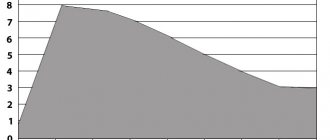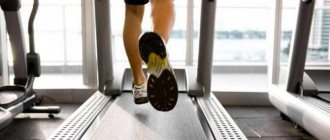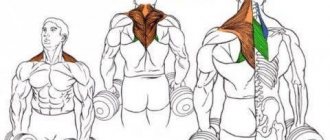Introduction
As you already know, the increase in results occurs not during training, but after it. Recuperative rest between workouts is essential to your progress. If there is an imbalance between the volume of training and recovery time, then a person in his training comes to a state of stagnation, when the growth of sports performance stops, followed by a decrease. If the process of superimposing each subsequent workout on the previous fatigue does not stop, the body enters a critical state - overtraining.
ADVICE. In order to understand how to structure the recovery period from training to training, we recommend studying the article “What is supercompensation.” In it, we described in detail the phases of recovery and on graphs gave examples of positive, neutral and negative dynamics of the processes of growth, retention and decline in sports results.
Diagnostic methods
Symptoms may not appear immediately, and the subjectivity of assessments gives ambiguous results. And after the fact, realizing that the state of overtraining has already occurred is not very pleasant. In order to diagnose such a imbalance in the balance of the body’s restorative forces in advance, there are a couple of methods for determining them:
- by measuring heart rate;
- Ruffier's test method.
Heart rate measurements
In a normal state, the body of a healthy person has a certain heart rate. This indicator may vary slightly by gender:
- 60 – 70 contractions per minute in men;
- 70 – 80 for women.
It is worth keeping a diary of the main physiological indicators of the body. Why a diary is needed does not need to be explained to bodybuilders: they base their workouts on it and constantly make adjustments throughout the entire period of the training cycle. If your heart rate starts to deviate from the norm, then it’s time to reconsider your training schedule. You can even see a doctor.
Measurements should be taken at the same time, for example, in the morning after waking up. Lie in bed for a few minutes, look at the ceiling and take several measurements over the same time interval. A deviation of 10 - 12 beats per minute already indicates the need to change something.
Ruffier's test
This method will help assess the capabilities of a particular person to perform physical activity . To carry out these measurements you will have to stock up on a sheet of paper, a stopwatch and a pencil. Before performing it, you must measure your heart rate in a calm state. Write down this value, calling it P1.
After this, 30 squats are performed at a speed of 2 repetitions in 3 seconds. In the first 15 seconds after this, measure your pulse. This indicator can be called P2. After half a minute, repeat the heart rate measurement, calling it P3. The formula calculates the Ruffier index: “I = (4x (P1 + P2 + P3) – 200)/10.”
Index values up to 10 indicate the normal state of the body. The range of 10 – 15 indicates the need to rest or reduce the amount of workload. At values above 15, it is better to stop training.
What is overtraining
Overtraining is a condition that occurs when the volume and frequency of training exceeds the body's recovery capabilities. Here in this paragraph, from the point of view of overtraining, we will explain why you need rest between workouts.
Why does this phenomenon even occur? This phenomenon most often occurs in beginners who expose their body to too much stress, as well as in those who train either too often, too hard, or both. What most often leads people to a state of overtraining is the misconception that supposedly, the more often you train, the faster the result will be achieved. Of course, you realized that this opinion is wrong. Now let's get into the essence of the process.
Mild overtraining will require you to take a few days off from training. If you continue to exercise in the gym, you will only worsen your condition. Fatigue will only accumulate, and fatigue will progress. In this case, to recover, you will need rest between workouts of several weeks or even several months, depending on the state into which you have driven yourself.
Of course, such a “rollback” in training will throw you and your results far back and you will have to start all over again. In such a situation, having the relevant information, you need to weigh everything and not beat yourself up. The process of superimposing one fatigue on another after each workout occurs as follows.
After the first workout, recovery begins. If you don't spend enough time on this process, then by the time you start your next workout, you won't be fully recovered. This is a typical situation where you haven't even recovered to your starting level, let alone built muscle. You carry out the next training, and the starting point “downwards”, in the direction of worsening the condition, will no longer be o on the conditional recovery scale, but o. That is, you have already begun to move towards reducing the effectiveness and efficiency of your training. You begin to enter a state of stagnation. In such a situation, the rest time between workouts urgently needs to be increased.
Development of overtraining
As a rule, three sequential processes lead to a state of overtraining:
1) Overwork. This is an extreme degree of fatigue, which manifests itself through signs of general fatigue and lethargy, however, it is not limited to them. If we assume that fatigue is a normal physiological response to physical activity, then overfatigue is a serious complication that easily develops into various types of dysfunction of the organs and systems of the body. In this case, recovery between workouts was already impaired earlier, which led to a deterioration in the functioning of organs and systems of the human body.
2) Overvoltage. A pathological disorder that is a consequence of excessive stress, both physically and emotionally. It often occurs both in a single organ and in several organs at once. Initially, it does not imply the occurrence of complications and does not affect physical activity. But to prevent its further development, it is necessary to at least temporarily stop training and carry out drug therapy. Otherwise, initially reversible disorders develop into diseases of certain organs.
3) Overtraining. In this state, the central nervous system is overstrained. This disorder is a disease and is called neurosis. A person is easily irritated, easily offended, sleep and appetite disturbances occur, and the desire to exercise disappears. Coordination of movements and heart rate are disrupted, blood pressure rises, and the functioning of the respiratory system worsens. Decreased hormone secretion slows tissue growth.
Overtraining occurs due to factors such as violation of the daily routine, various diseases, fatigue at work, poor nutrition and more. Most often, this condition develops in competitive athletes, for whom constant high loads are the norm. In such a situation, we can state the fact that restorative rest between training sessions was either absent or proceeded with significant disruptions.
What are the symptoms of overtraining? As a rule, they manifest themselves as follows. There is no progress in training, a person feels a loss of strength, quickly gets tired, becomes depressed, easily irritated, loses appetite and, as a result, his immune system is weakened. Now you already fully understand why you need rest between workouts and what the violation of the recovery period leads to.
Possible complications
Symptoms of overtraining are not immediately noticed. But if the body’s signals are nevertheless noticed, measures should be taken to cope with the problem that has arisen. If this is not done, both minor and quite severe complications are possible.
Negative consequences of overtraining:
| Gaining excess weight | Although an overweight person is advised to undergo fairly intense physical activity to solve the problem, the result may be the opposite. This is due to several factors.
|
| Overtraining syndrome | Intense physical activity with a lack of rest can cause chronic stress. Which, in turn, is associated with adrenal problems. The adrenal glands become exhausted and reduce the production of hormones that are important and necessary for the body. All this leads to overtraining syndrome - loss of appetite, chronic fatigue, and violation of the regime. |
| Women's problems | The body of any woman is at risk if she trains intensively. Even non-professional athletes, without controlling physical activity and rest, can encounter problems such as:
|
| Decreased immunity | The immune system suffers greatly from constant and excessive physical activity without rest. When problems with hormonal levels, pain in muscles and joints are added to this, the body is at risk. Any infection or inflammation can increase and develop into a serious illness. |
| Heart problems | Frequent endurance exercise over a long period of time can lead to unpleasant and dangerous consequences such as arrhythmia, thickening of the heart valves, changes in blood pressure, and damage to arterial walls. |
| Depression and mental suffering | In the long term, overtraining burdens the entire body, and therefore the mental state. Lack of success in sports and physical discomfort contribute to the development of depression and personality changes. |
Overtraining and its symptoms can have a fairly negative impact on the quality of life of an active person. To avoid this, you need to carefully consider the training process and purposefully give the body time to regenerate.
Without sufficient recovery time, progress will not be made and there will be no positive emotions from the exercise.
Preventing Overtraining
How to carry out prevention? In order not to drive yourself into a state in which overtraining will have to be treated, it is necessary to prevent its development. Prevention using application methods is similar to treatment and consists of proper nutrition, moderate training and quality sleep.
How to avoid overtraining? The approach to treating this condition is to increase the recovery period, meaning you need to rest longer between workouts. It is necessary to increase the break between workouts, reduce their volume, increase sleep time, review your diet, and it is advisable to periodically undergo a massage procedure. If you return to training and notice progress again, you can consider that the process of treating overtraining has been successfully completed.
Symptoms of overtraining: what are they and how to deal with them?
Fatigue?
Read more: How to exercise on a stepper correctly
Are you familiar with the state of not standing either during training or after it? Most often, this phenomenon is characterized by complete aversion to the training process, and the mere mention of the gym makes the athlete gag.
If you have ever had to deal with something like this, then know that most likely a cat crossed your path due to overtraining.
In this article, we will learn how to identify the symptoms of overtraining and learn some practical tricks that will help combat it effectively.
Well, are you ready? Then the key is to start, let's go.
I would like to start with the fact that this article is a continuation of the sensational blockbuster of our previous article [Overtraining], in which we were generally introduced to this condition as such.
In addition, shortly after the publication of the first note, I (via the feedback form) began to receive letters from my readers (you) asking for help identifying symptoms of overtraining. Because
There were an incredibly decent number of requests of this kind, I thought it would be stupid not to take advantage of the current situation and combine my answers, broadcasting them all through one article. Actually, the latter was done.
So, let’s remember in a nutshell what kind of misfortune this is – overtraining.
It is characterized by a failure (or deviation from their normal functioning) of most body systems.
Compensatory in this case is meant as the body’s response to a changing mode of its operation.
Understanding the nature and mechanisms of occurrence of this condition is impossible without knowledge of the model of the training process. In particular, it has the following phases, which look like this (see image).
As can be seen from the figure, the “training-recovery” model consists of several phases:
- training stimulus – physical activity itself;
- fatigue – depletion of the body’s reserves;
- restoration – replenishment of reserves to the original level;
- supercompensation – super-recovery (more than the original values).
- decline
A state of overtraining occurs when one side of the scale (catabolic processes) outweighs the other (anabolic processes). This is very clearly demonstrated by the following image.
The diagram shows various processes occurring in the human body during certain periods of intensity of its training process, as well as overtraining syndrome.
During a period of high activation of anabolic (recovery and construction), metabolic (the body's ability to generate energy) processes, the state of performance (overall performance) will be close to maximum, while catabolic processes remain relatively low.
Once the body passes the zone (“over-activation”), its performance (in this case strength) begins to decrease, and the heart rate continues to increase and rises above the baseline level.
After the “over-activation” phase, the level of catabolic processes begins to increase sharply (they significantly outweigh anabolic ones), and the further (to the right of the diagram we move) the body works, the more it “drives” itself into a state of stress and decreased productivity. We've sorted out the diagram, now let's look at the general diagram of the effects of overtraining on the body. So, this is the “circle” that occurs (see image).
When an athlete’s body is tired (although the person himself may not yet feel it), this leads to a breakdown in the finest motor coordination and a decrease in the body’s adaptability to physical activity.
The latter, in turn, leads to the appearance (accumulation) of a large number of inflammatory processes and microtraumas.
Ultimately, the overall level of cytokines rises, which activate (via a signal from the central nervous system to the adrenal glands) the production of stress hormone.
Cytokines are cells of the immune system that interact with other cells, stimulating or inhibiting their functions.
So, we’re done with smart thoughts and scientific calculations, we’ll just fool around :). Let's move on to the second – practical – chapter.
I think you have a question: how to recognize overtraining syndrome. There are many methods for this, in particular, the three most common are:
- documenting heart rate (heart rate) over time when performing certain exercises;
- Ruffier test
- Heiki Rusko orthostatic test.
Read more: How to run correctly to lose weight in the stomach and legs, when is the best time to train and how to breathe, video
We have already described the first two methods in the article [Overtraining], so we will not repeat them, but we will present the calculations of the latter. Here's what you need to do:
- lie down and rest for 10 minutes at the same time (in the morning) every day;
- after 10 minutes, record your heart rate in beats per minute;
- stand on your feet;
- after 15 seconds, measure the second heart rate value;
- after 90 seconds - third;
- after 120 seconds - the fourth.
Athletes without overtraining syndrome (well-rested) should demonstrate average heart rate values (without visible jumps). Those athletes who are on the verge of stress will show a noticeable increase (more than 10 bpm) in the last measurement while standing.
We're done with the measurements, let's move on.
Not many people know that there are certain types (types) of overtraining, in particular, the following can be distinguished (see image).
Our next step is to become “personally” familiar with the symptoms of overtraining.
There are quite a large number of them, and so that you do not get confused, I decided to systematize them and present the results in the form of the following diagram.
The cause of all the above symptoms is the result of the interaction of three factors:
- heavy physical activity;
- insufficient rest;
- non-training physical and psychological stress.
The third group of factors is especially unpleasant, because often depends not only on the person, but also on his environment, life situations, etc. So, we’ve sorted out the symptoms, let’s move on.
Now let's answer the question: how to avoid overtraining.
Firstly, you need to very carefully monitor your body’s feedback signals, and at the slightest sign of overtraining, immediately get down to business. The latter is about working on two fronts: in the gym/fitness room and outside of it.
How to avoid overtraining? Tips for the gym.
Use the following tips when you feel this syndrome creeping up on you:
- increase the rest time between workouts (go to the gym every 2-3 days);
- reduce the total number of sets and repetitions in your training program;
- reduce the load (working weights) by 10-15% and work for about 2-3 weeks in this mode;
- do not combine weight lifting with other active sports (boxing, sex, athletics, etc.);
- pay attention to the technique of performing your exercises, perhaps you should “tweak” it;
- adjust your training program if life circumstances change;
- do not change the training program more than once every 3-4 months;
- determine the minimum amount of training that will ensure your progress;
- do not allow the same muscle group to be worked too often (for example, beginners like to pump their chest 2-3 times a week);
- replace complex basic exercises with their simple analogues: squats with a barbell - leg press in a machine, lunges with a dumbbell; deadlift - bent over barbell row; pull-up - traction of the upper block, etc.;
- always stretch your muscles before and cool down after training;
- do not try to imitate anyone in the gym, much less lift weights that are not your own;
- remember - the harder the training, the lower the immunity becomes, so you shouldn’t “punch” constantly to the limits of your capabilities;
How to avoid overtraining? Tips outside the gym.
The following tips will help you avoid the unpleasant state of inability to stand:
- sleep 8 hours at night and 45-60 minutes during the day and get up on your own, and not with a sleep aid;
- eat fully 4-5 times a day (break between meals 2.5-3 hours);
- eat foods rich in protein and carbohydrates, and don’t forget about healthy fats;
- include more vitamins C and E in your diet, as well as mineral complexes from the pharmacy;
- ask for a deep muscle massage;
- practice various types of stress relief: yoga, meditation, etc.
Remember! Overtraining is most often the lot of experienced athletes, but for beginners another syndrome is more typical, and its name is “undertraining” or “I don’t want to be trained” :).
Uff-f, in my opinion everything, although... No, definitely everything. Now let's sum it up and say goodbye.











